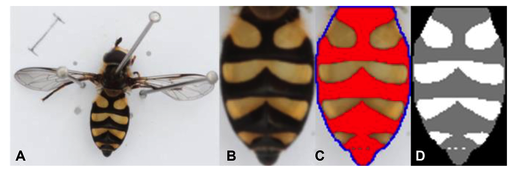


Although some hoverflies beautifully resemble their hymenopteran models, others seem to be poor mimics or are apparently nonmimetic. The reasons for this variation are still enigmatic despite decades of research. Here, we address this issue by mapping social-wasp mimicry across the phylogeny of Holarctic hoverflies. Using the “distance transform” technique, we calculate an objective measure of the abdominal pattern similarity between 167 hoverfly species and a widespread putative model, the social wasp, Vespula germanica. We find that good wasp mimicry has evolved several times, and may have also been lost, leading to the presence of nonmimics deep within clades of good mimics. Body size was positively correlated with similarity to the model, supporting previous findings that smaller species are often poorer mimics.
Additionally, univoltine species were less accurate wasp mimics than multivoltine and bivoltine species. Hence, variation in the accuracy of Batesian mimics may reflect variation in the opportunity for selection caused by differences in prey value or signal perception (influenced by body size) and phenology or generation time (influenced by voltinism).
Batesian mimicry, where palatable prey avoid predation by evolving features to resemble defended model species (Bates 1862), not only provides an iconic example of adaptation by natural selection, but also presents a paradox that has challenged evolutionary theory for the last 159 years (Gilbert 2005; Ruxton et al. 2018). Theory predicts that constant selection pressures imposed by predation should improve mimetic accuracy (Cuthill and Bennett 1993; Dittrigh et al. 1993; Edmunds 2000; Gilbert 2005; Rotheray and Gilbert 2011). However, mimicry is frequently far from perfect (Speed and Ruxton 2010; Edmund and Reader 2014; Taylor et al. 2016a). Attempts to comprehend the existence of imperfect mimicry have produced an extensive series of hypotheses (see McLean et al. 2019 for a review).
Although some of these hypotheses are now regarded as implausible, great uncertainty remains over which factors are most important in the persistence of imperfect mimicry.